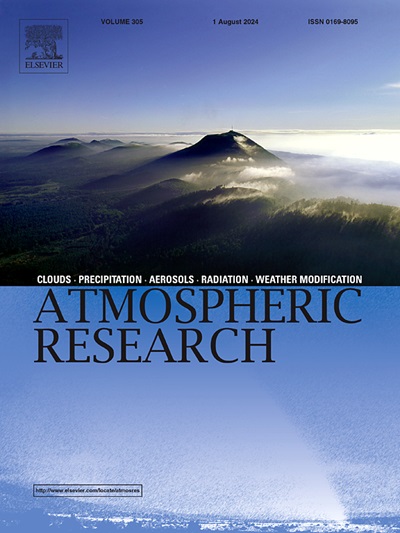Remote sensing of Arctic marine fog using ship-based ceilometer
IF 4.5
2区 地球科学
Q1 METEOROLOGY & ATMOSPHERIC SCIENCES
引用次数: 0
Abstract
Arctic marine fog is a severe disastrous weather characterized by drastically reduced visibility, and its occurrence often poses great challenges to navigation and aviation. Accurate measurement of the characteristics of the Arctic marine fog plays a significant role in improving the accuracy of marine fog forecasts in the Arctic region. The Vaisala CL31 ceilometer, with its high sensitivity to liquid water content (LWC), is an effective means of detecting and obtaining the vertical structure of marine fog. In this work, a method to detect fog and retrieve fog thickness based on the ceilometer's backscatter coefficient profile has been proposed. The dataset collected at the Multidisciplinary drifting Observatory for the Study of Arctic Climate (MOSAiC) expedition from September 2019 to September 2020 is analyzed. Results indicate that compared with fog detection results of present weather detector (PWD22), the average deviation of marine fog occurrence probability of the proposed algorithm is within 5 %. Meanwhile, Arctic marine fog has obvious seasonal cycle, with the probability of high-concentration large-particle Arctic marine fog reaching up to 40 % in summer, accompanied by the thickness basically below 300 m. The distribution of marine fog thickness in summer is more concentrated and can last longer, with an average duration of about 6.24 h. In addition, there is an obvious correlation between the marine fog and the atmospheric boundary layer, with the correlation coefficient (CC) between the boundary layer height and the marine fog thickness being 0.7. However, the marine fog is generally shallower than boundary layer height in most cases.
用船载云雾计遥感北极海洋雾
北极海洋雾是一种严重的灾难性天气,其特点是能见度急剧降低,它的发生经常给航海和航空带来巨大挑战。准确测量北极海洋雾的特征对提高北极地区海洋雾预报的精度具有重要意义。维萨拉CL31型测雾仪对液态水含量(LWC)具有很高的灵敏度,是探测和获取海洋雾垂直结构的有效手段。本文提出了一种基于ceilometer后向散射系数曲线的雾检测和雾厚检索方法。对2019年9月至2020年9月北极气候研究多学科漂流观测站(MOSAiC)考察队采集的数据集进行了分析。结果表明,与现有气象探测器PWD22的雾检测结果相比,本文算法对海洋雾发生概率的平均偏差在5%以内。同时,北极海雾具有明显的季节周期,夏季出现高浓度大颗粒北极海雾的概率高达40%,厚度基本在300 m以下。夏季海洋雾厚度分布较为集中,持续时间较长,平均持续时间约为6.24 h。此外,海洋雾与大气边界层存在明显的相关关系,边界层高度与海洋雾厚度的相关系数(CC)为0.7。然而,在大多数情况下,海洋雾通常比边界层高度浅。
本文章由计算机程序翻译,如有差异,请以英文原文为准。
求助全文
约1分钟内获得全文
求助全文
来源期刊

Atmospheric Research
地学-气象与大气科学
CiteScore
9.40
自引率
10.90%
发文量
460
审稿时长
47 days
期刊介绍:
The journal publishes scientific papers (research papers, review articles, letters and notes) dealing with the part of the atmosphere where meteorological events occur. Attention is given to all processes extending from the earth surface to the tropopause, but special emphasis continues to be devoted to the physics of clouds, mesoscale meteorology and air pollution, i.e. atmospheric aerosols; microphysical processes; cloud dynamics and thermodynamics; numerical simulation, climatology, climate change and weather modification.
 求助内容:
求助内容: 应助结果提醒方式:
应助结果提醒方式:


